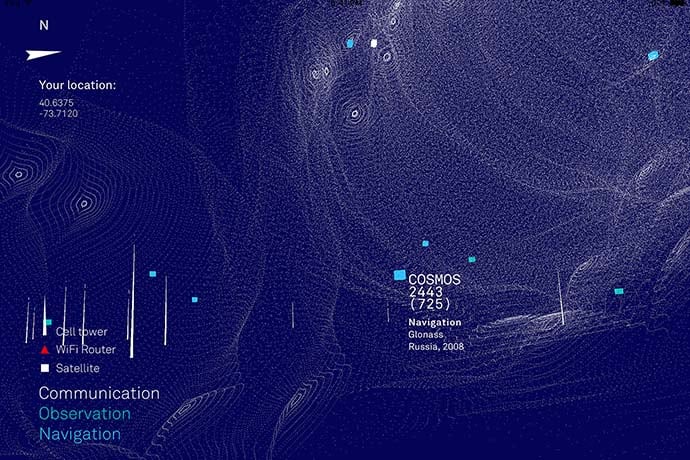When you pull out your phone or tablet (or desktop computer, if you’re a dinosaur) and call up a web page in a web browser, or use a social app, it’s magic, right? Somehow your device displays data on your computer screen without wires. The same happens if your car has a dashboard map device.
How does this happen? You might logically know how the internet and broadcast work. However, if it’s all invisible, does it really exist?
There is an invisible world, part of an infosphere, which includes devices that broadcast data to our computers. In the same way the biosphere has many different animals, plants, and other elements, the devices in the infosphere have many different pieces. Satellites, for example, broadcast signals computers use to fix your location as you drive or walk down the road. Wi-Fi boxes broadcast data to and from the internet to your computer. Cell towers transmit your mobile phone calls.
The Architecture of Radio app shows this amazing digital infosphere. You can see how your Wi-Fi box, for example, broadcasts huge circles of radio waves. These waves undulate and mix like ocean waves as they bounce off walls and pass through doorways. Your location in the wi-fi circle determines whether your connection is strong or weak. Or you can see and learn about GLONASS, INTEGRAL, FORMOSAT, and other satellites flying above your head in space, broadcasting signals down.The Architecture of Radio app is easy to use: point your phone or tablet anywhere around you. To identify a source, place it in the center of your screen and hold your device long enough for the identifying information to appear.
Described as a “field guide to the hidden world of digital networks,” the app was created by a Dutch artist, Richard Vijgen. His design studio explores stories within massive data sets, always looking for a connection to the physical world and social space people inhabit. The data set used to visualize the hidden world of radio waves around us includes 7 million cell towers, 19 million Wi-Fi routers, and hundreds of satellites. These signals are acquired and identified using the OpenCellID open source data set for cell towers, as well other open source data sets to identify Wi-Fi router and satellite signals.
The app works on iOS (Apple devices) and Android devices. It costs $2.99 which is not much for such an educational and fun app. Especially since it is an unusual way to see and explore a vital but hidden part of our daily lives. It’s perfect for teachers to explain how the internet works with mobile devices, as well as how cell phones and other technology we take for granted works.
Learn More
The Architecture of Radio
http://www.architectureofradio.com/
https://itunes.apple.com/us/app/architecture-of-radio/id1035160239?ls=1&mt=8
https://play.google.com/store/apps/details?id=nl.richardvijgen.architectureofradioAndroid
Richard Vijgen
The Architecture of Radio Video
OpenCellID
http://opencellid.org/
http://wiki.opencellid.org/wiki/What_is_OpenCellID
https://en.wikipedia.org/wiki/OpenCellID

